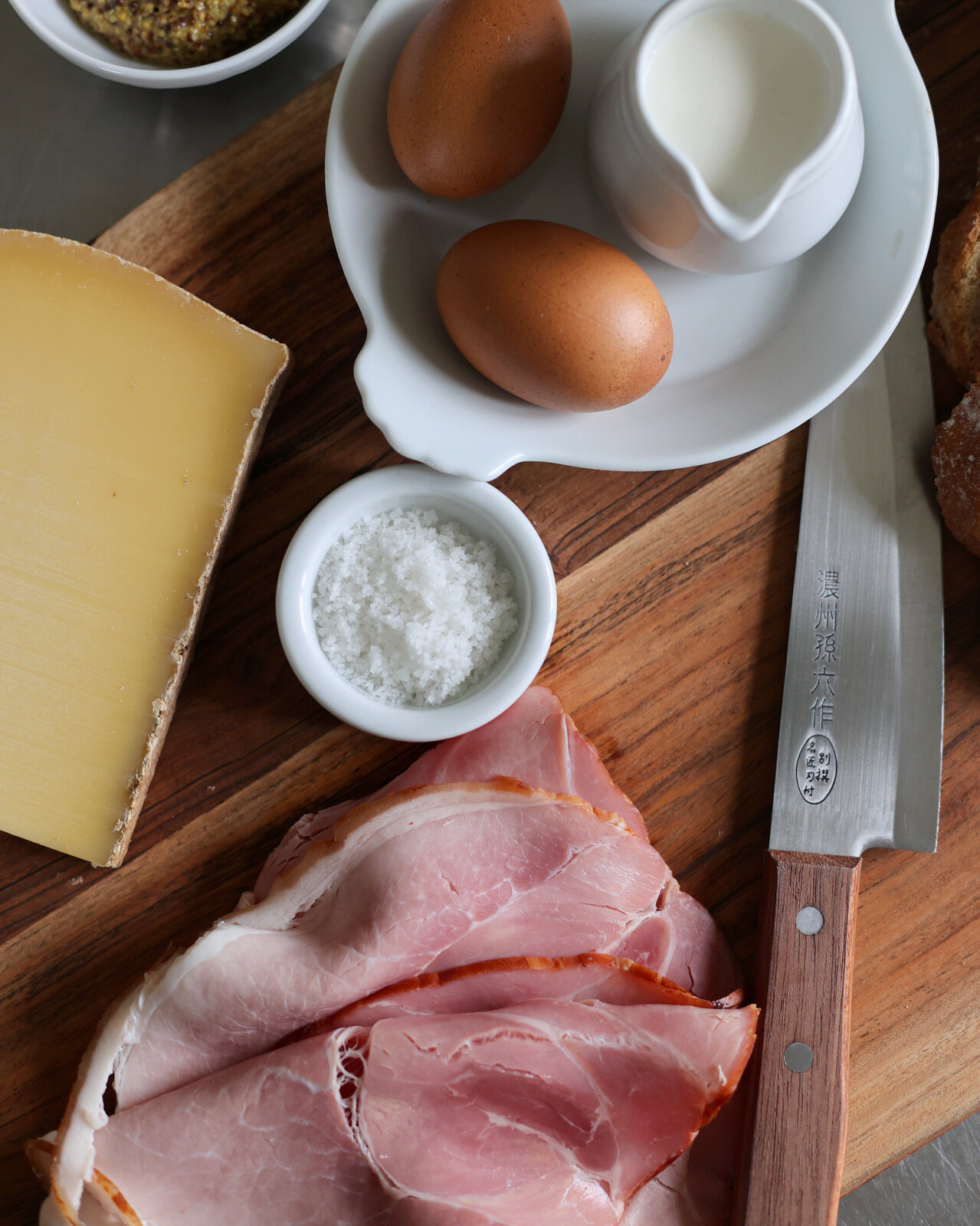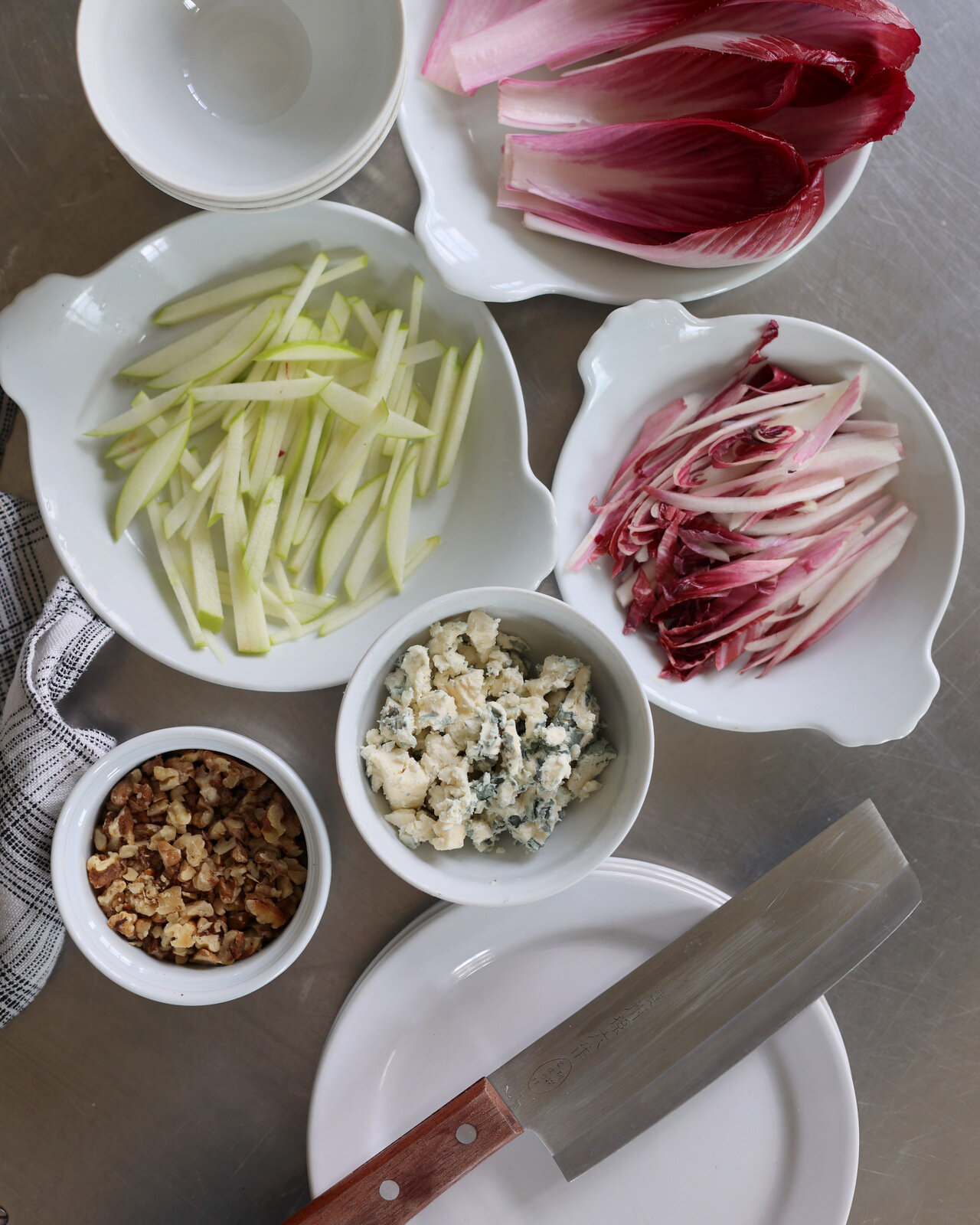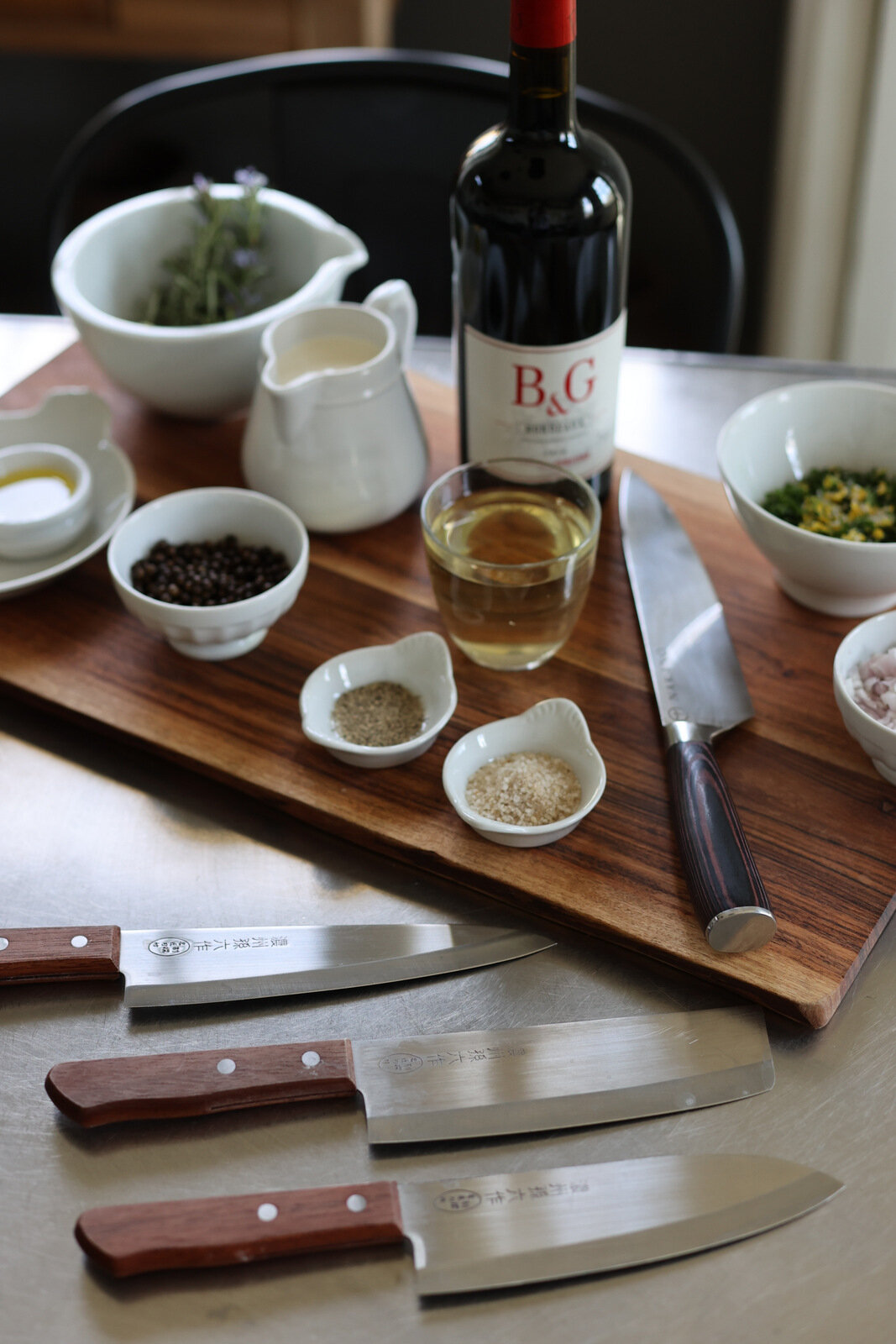Rabbit Hill Kitchen - Knives 101
BONJOUR!
There is no object you own that is anything like your kitchen knife. Every day you pick it up and use it to create and transform. This, I suppose, could be true of a paintbrush or a keyboard, but the knife is more than a creative or functional tool … A kitchen knife carries a cultural, historical and technological load out of all proportion to its simple structure. A knife has a beautiful purity of purpose, it’s almost the perfect expression of form that precisely follows function. Knife, The Culture, Craft and Cult of the Cook’s Knife. 2016
Over the past few weeks we have touched about techniques that will aid in perfecting our culinary skills and I had also mentioned that I felt that ‘tools’ were the other side of that coin. Although a spatula or a whisk might come to mind as the most essential items in your kitchen drawer — the knife is at the top of my list. Years and years ago - when I first started watching food TV shows - it seemed odd to me, why a chef or cook would arrive with their personal knife-roll. (Who could forget — ‘Please pack your knives — and go” !?) But soon, I learned the importance of a good knife and maybe even more so — a good knife that you KNOW. Have you ever cooked in someone else’s kitchen? It almost feels about the same as camping. You might have a good spoon or a basic knife (the paring knife is the number one choice when asked what knife most home cooks prefer.) a cutting board, spatula — maybe some tongs. When I used to do catered dinner parties, I learned to pack all of my favorites — having my own kitchen tools supported my confidence in cooking in ‘foreign’ spaces. When I travel to the US to teach cooking workshops - you can bet there is an extra suitcase of kitchen essentials going with me!
Knives - 101 - What you need to know
BRAND. My first ‘real’ knife set was from Costco (although I had inherited a few Cutco Knives as my brother was selling them when I was in college). The set from Costco was in the style of Wusthof knives but not as expensive. I have to tell you — those knives lasted for years! They were not terrible! In fact, they lasted until we moved to France, over ten years ago, when they were replaced by Zwilling J.A. Henckels knives that we purchased from a local restaurant supply store. Those I still have as well. But what I learned was that BRAND is not always that important. In fact, I purchased the same ‘style’ of knives made by Top Chef for my workshops — and they are really good too! What is more important is how the knives are made and the materials they are made from.
MATERIALS. The first knives in primitive times were made from flint, bone and wood. Here is a list of the various choices we have in our modern world:
Carbon Steel. Carbon steel is essentially iron with a little carbon added in, which makes for a stronger blade that keeps an edge much longer than a solid iron blade. While these knives are known for being solid workhorses, they also rust easily and don’t stand up very well to acidic compounds. If properly seasoned, carbon blades become more resistant to breakdown.
Still, a good carbon steel knife will last forever if properly cared for.
Stainless Steel. This is what most standard household knives are made of. In the early 20th century, stainless steel was developed by adding chromium to carbon steel to make it more durable and resistant to rust. Stainless steel is also much slower to corrode when exposed to acids (hence the name stainless steel, duh). It’s important to note, though, that no steel knife is completely invincible – they all break down when exposed to acids, salts, and moisture.
High-Carbon Stainless Steel. High carbon stainless steel is basically stainless steel with a little more carbon added. This is supposed to make the knife both stain resistant and more capable of holding an edge, but while high carbon cutlery may hold its edge a little longer than standard stainless steel, it’s not by a huge margin.
Damascus Steel. Damascus, or pattern welded steel, is more of a process than a type of metal. By taking a few different kinds of steel and layering them together, artisan knife-makers achieve unique patterns in their cutlery. Take a peek and you’ll notice that Damascus knives have interesting-looking patterns throughout the metal blade, and these patterns actually go all the way through the knife. Anything called “Damascus-look” isn’t really damascus at all; it’s most likely a superficial pattern in the surface of the metal that just looks pretty.
Other Metals. Knife manufacturers put all sorts of metals in their steel mixtures. They can contain such compounds as cobalt, nickel, manganese, and others, each having their own properties. There’s no such thing as “the perfect knife” – each manufacturer will tell you that their steel recipe is the best for X and Y reasons. In the end — the only way to truly understand which knives are stronger and sharper is to use them yourself.
Ceramic. Ceramic knives are becoming more popular these days, and they’ve got a few advantages: they’re super lightweight, and they don’t stain, rust, or react to acids. The downside is that they can chip or shatter if not cared for properly, and that’s why I chose to pass on this type. I’m not a fan.
(This content was originally posted on FearlessFresh.com and has been used as a reference for this post).
HANDMADE VS. MACHINE-MADE. This is one area where I truly believe you get what you pay for. You can purchase a really great knife that rolls through an assembly line and is made of high quality material and has a blade stamped with a renown brand — or you can purchase a knife that spent many hours and days in the hands of an artisan (and the blade is signed if you are lucky!) I have both in my knife collection - as I was gifted an artisan made knife that I could not afford otherwise. I have to tell you — it’s outstanding and blows all of my other knives, out of the knife drawer. This is what it looks like and even though it’s a little samurai looking in my opinion — the blade is so exceptional, it is currently my most used knife. I feel the difference between the machine- made and handmade knives is ‘soul’ — I think you can feel the dedication and craftsmanship in an artisan knife, that makes it more than just an essential tool.
But what is more important? UseS!
Ever try to cut a tomato with a butter knife? A baguette with a steak knife? Or a roast with a paring knife?
I think growing up — my mom had three types of knives in her kitchen drawer. A paring knife, a serrated knife and a set of steak knives (which seemed to be used for everything!) As a child of the processed food generation — not a lot of whole foods were being made in the kitchen, outside of chopping an onion or dicing celery. On Sunday the steak knife sets would be on the table so that we could manage to cut our roast beef.
But now — as so many are accomplished home-cooks or foodies — knives and food prep have hit a new level of precision. Do you recognize any of these names of ‘knife strokes’? The chop, the rocking chop, the push slice, the pull slice, the ‘locomotive’ (I did not make that one up!) the sawing cut …?
Standard types of knives; Western and Japanese - 2021 Rabbit Hill Kitchen
GUIDE TO THE MOST ESSENTIAL KNIVES:
So what’s in your knife drawer? Here are the basic types of knives and their uses …
The Chef’s Knife - Uses: general purpose. Called the ‘most desirable’ of all French pattern kitchen knives, it’s the major chopper in your kitchen. The curved blade lends to the ‘rocking’ type of chopping and dicing. Find my favorite here.
The Utility Knife - Uses: filleting, skinning, boning and slicing. The long thin blade passes through food items, smoothly. Most often used for the pulling method of slicing. Less surface area allows it to ‘glide’ and not get stuck in meats or fish.
Santuko ‘chef’s knife’ - Uses: all purpose. This knife is a user-friendly version of the classic chef’s knife, with the addition of the grooves in the blade that help it not to get stuck in ‘suction’ as it glides through potatoes, root vegetables, meat, and fish. It’s also a great chopper and easier to handle than larger chef’s knifes. Find my favorite here.
Nakiri Knife - Uses: vegetable cutting and peeling. I love this knife for all of my vegetable prep! It is the ultimate blade for ‘julienne’ and small dicing. The name Nakiri, indicates that it is meant for cutting greens and it chops through cabbage and kale with easy precision. I loved this knife from the first time I used it! This is the set that introduced me to Nakiri.
Petty Knife - Uses: all purpose. The name of the Petty knife is said to be derived from the word 'petit', meaning 'small' or 'little' in French. The Petty knife is seen as a smaller version of the Gyuto, the Japanese chef's knife. The Petty knife is also sometimes referred to as a Japanese paring knife or a Japanese utility knife.
Paring Knife - Uses: also called the ‘office’ knife, for all veggie prep, peeling and slicing. Many cooks that are uncomfortable with the large chef knife will reach for the small paring knife, although it is challenging, due to its blade size, to do chopping or dicing. I think this is the ultimate paring knife.
Cleaver - Uses: largely used as a kitchen or butcher knife and is mostly intended for splitting up large pieces of soft bones and through thick pieces of meat. The knife's broad side can also be used for crushing in food preparation (such as garlic) and can also be used to scoop up chopped items.
Bread Knife - Uses: cutting and slicing bread. Looking for a pretty and durable bread knife? This set is gorgeous.
Steak Knife - Uses: slicing meat and poultry, often as part of a table setting.
Filet Knife - Uses: fileting and skinning meat.
Butter Knife - Uses: cutting butter and for use with spreading butter and cheese.
Boning Knife - Uses: Boning meat or poultry. These knives are usually shorter and narrower across the blade.
Hey Good Lookin’! Are looks important too?
I say YES! It’s your kitchen and a knife (or a pot or a pan) should reflect your style. And sometimes looks also play into function. I love a smooth wood handle, but some knives ‘slip’ in your hands. I love a utility knife with a solid black handle and rivets, but prefer a more carved ergo dynamic feel in my hand. Your grip (the way you hold the knife) is a really important element. If you aren’t comfortable handling a knife — you won’t use it. As well, you won’t use a knife that is hidden in your knife drawer because it’s not nice to look at. I would say in the category of ‘pretty’, these Mito knives that I recently received from Nakano Knives — win hands down. Plus the handles feel great in your hand and the blades are crazy sharp!
What’s in my knife drawer? My Top 3:
No.1 Pick: I have to say that my number one choice is a chef’s knife, for obvious reasons. If you can handle a big knife (the blade is normally 8” or more) then I think you will find this one is the most versatile for all kinds of chopping, dicing and cutting. It is not the best slicing knife for meat or poultry however, because the wide blade does get ‘stuck’ with suction in some foods instead of gliding through.
No. 2 Pick: The all-purpose paring knife. This is a good choice if you are doing finer work and for peeling it is a must.
No. 3 Pick: I would have to go with the Santuko as my second first choice actually — because it is similar to a chef’s knife but smaller. I find it user friendly for those daunted by bigger blades, and can do all the same cuts and chops.
Because I have been doing photography work for Nakano Knives, I have had the chance to try so many of their great knives. Although this isn’t a sponsored post, I had to mention the ones I love best, as having new knives has really opened up my cutting capabilities in my kitchen. I am more inclined to do a finer dice or julienne and chopping does go much faster and more consistently. One thing I want to mention in wrapping up, is that knives come first and knife-skills follow. I don’t think it’s possible to do better with knife skills if you are using sub-par knives. Speed and fancy tricks are not important - honestly, I am more of a slow and precise (and careful!) knife skills fan.
I hope this brief tutorial on Knives 101 has been helpful! If you have read this far (thanks!) … and I wanted to share a little SURPRISE that will be coming up at the end of our workshop. During our farewell ZOOM meet-up, I will be drawing a name to give-away one of Nakano’s NEW premium knives. The Nakano White Ash chef’s knife is a stunning addition to their collection and I will be gifting one — to one of you! All you need to do is to hop back on our page — and comment on the blog post announcement by telling me what your favorite kitchen tool is in your kitchen!
And finally, I wanted to add this recommendation - if you are interested/obsessed with knives as I am, or are looking for a book that will open you mind to the possibilities of the knife world — this is for you! Take a look here … KNIFE by Tim Hayward. I got lost in it — right away!
See you back on our group page!
A bientôt,
Cat
.












